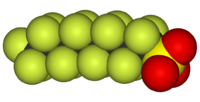
Photo from wikipedia
Understanding the biological impacts of plastic pollution requires an effective methodology to detect unlabeled microplastics in environmental samples. Detecting unlabeled microplastics in an organism generally requires a digestion protocol, which… Click to show full abstract
Understanding the biological impacts of plastic pollution requires an effective methodology to detect unlabeled microplastics in environmental samples. Detecting unlabeled microplastics in an organism generally requires a digestion protocol, which results in the loss of spatial information on the distribution of microplastic within the organism and could lead to the disappearance of the smaller plastics. Fluorescence microscopy allows visualization of ingested microplastics but many labeling strategies are nonspecific and label biomass, thus limiting our ability to distinguish internalized plastics. While prelabeled plastics can be used to avoid nonspecific labeling, this approach precludes the detection of environmental microplastics in organisms. Also, using prelabeled microplastics can affect the viability of the organism and impact plastic uptake. Thus, a method was developed that employs nonspecific labeling with a tissue-clearing technique. Briefly, unlabeled microplastics are stained with a fluorescent dye after ingestion by the organism. The tissue-clearing technique then removes tissue-bound dye while rendering the structurally intact organism transparent. The internalized plastics remain stained and can be visualized in the cleared tissue with fluorescence microscopy. The technique is demonstrated using polystyrene beads in living aquatic organismsTigriopus californicusandDaphnia magnaand by spiking a model vertebrate (Cephalochordata) with different microplastics.
Journal Title: Environmental science & technology
Year Published: 2023
Link to full text (if available)
Share on Social Media: Sign Up to like & get
recommendations!